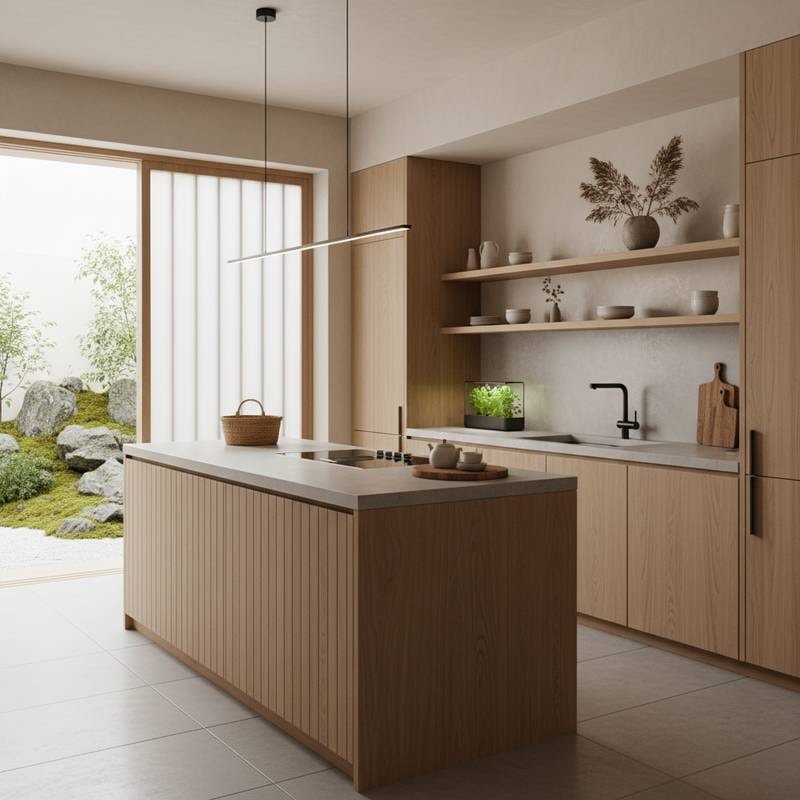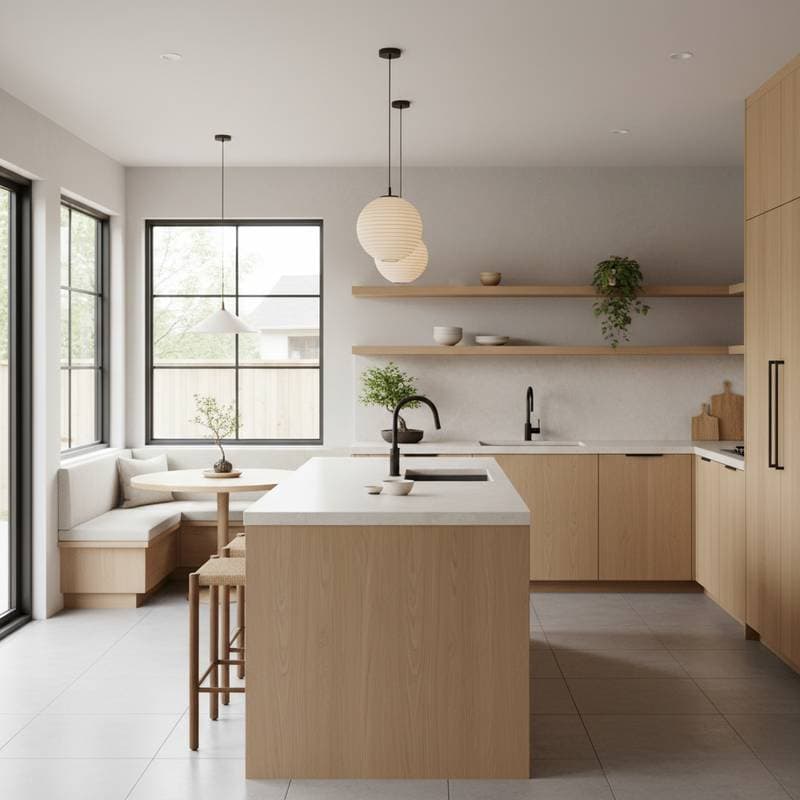Why Japandi Kitchens Lead 2025 Renovations
Design philosophies emerge periodically to influence daily living, cooking, and social interactions. The Japandi kitchen embodies cultural fusion, combining Scandinavian practicality with Japanese restraint. This approach yields environments that remain stable and refined, drawing from skilled workmanship while adapting to contemporary needs. As trends favor tranquility and genuineness, Japandi kitchens emerge as the preferred style, showcasing respect for organic substances, deliberate scaling, and lasting elegance.
1. The Core of Serene Utility
Japandi design centers on establishing equilibrium in the atmosphere. The kitchen transcends mere food preparation; it serves as a refuge marked by precise outlines, lack of excess, and sensory links to the outdoors. Professionals such as Norm Architects and Keiji Ashizawa Design illustrate how moderation conveys depth. They integrate light-toned oak storage with smoothly polished stone tops to produce kitchens that inspire reflection while supporting daily tasks.
Matte surfaces and gentle hue shifts prove vital. Neutral tones like Farrow & Ball School House White or Benjamin Moore Seapearl provide a peaceful foundation. Subdued accents in charcoal, gray, or muted earth tones introduce layered nuance. Natural illumination functions as an element in its own right, flowing over varied textures to accentuate the precision in seams and fixtures.
2. Authentic Materials and Flawless Execution
Japandi kitchens attract through their sensory truthfulness. Selections prioritize not only visuals but also aging patterns and tactile qualities. Options such as European oak, bamboo, and rift-sawn walnut suit storage units, as they display inherent patterns and subtle variations. Tops in polished limestone or soapstone offer understated variation, and artisan-made ceramic tiles impart a handmade quality beyond mechanical uniformity.
Architect Nina Bruun characterizes this method as a conversation between substance and creator. Each surface, connection, and intersection receives meticulous attention. Fixtures might integrate directly into timber rather than attach separately, forming uninterrupted forms that honor skilled assembly. The outcome is a personalized, resilient kitchen that conveys individuality over mass production.
3. Tempered Minimalism
Conventional minimalism occasionally appears cold, yet Japandi infuses coziness via texture and shade. A subdued spectrum forms the base but avoids monotony. Blends of beige, soft brown, and beige tones combine with restrained greens or hazy indigos to mimic organic scenes. Experts frequently match sleek stone with rough fabric, braided fibers, or textured metal to foster material interplay.
Illumination demands purpose. Rather than harsh embedded lights, hanging elements from rice paper or molded glass emit soft radiance, evoking traditional lamps. Companies including Menu, FLOS, and HAY offer pieces that align with the subdued style through elegant forms. This setup generates a subtle play of brightness and dimness that enhances routine activities.
4. Embrace of Living Materials
Homeowners now seek substances that possess vitality. Japandi kitchens deliver with elements that adapt and mature gradually. Untreated timber gains character, lime-based coatings diffuse light gently, and raw stone shows faint marks from handling. Such traces represent engagement and progression rather than defects.
Firms like Studio McGee and Olivier Simon Design adopt this mindset, choosing treatments that value irregularities. An central counter wrapped in irregular travertine, alongside exposed racks in sturdy ash, projects understated refinement. Broad timber planks sealed with plant oils prolong the soothing effect across the floor. Fixtures receive similar consideration; untreated metals like brass or bronze gain distinctiveness over time, underscoring enduring allure.
5. Balanced Spatial Dynamics
Equilibrium in scale characterizes effective Japandi kitchens. Arrangements emphasize unity between expanse and closeness. Central features remain proportionate to facilitate circulation and views, while storage follows uniform cadence and ratio. Attention to unoccupied areas employs moderation to generate visual ease.
Structural elements reinforce this precision. Concealed bases suggest levitating units. Exposed racks substitute enclosed overhead storage to reduce visual weight and showcase pottery or timber vessels. The collective impact is orderly composure, where each item serves a role and each contour appears purposeful.
6. Integration with Daily Practices
Japandi kitchens honor routine ceremonies, from brewing beverages to displaying fresh harvests. Clear surfaces promote attentive engagement. A modest ledge may support a crafted vessel, and a rock basin sits on the surface as an artistic piece. These items unite utility and creativity, echoing wabi-sabi values of transience and plainness.
Designer Marie Olsson Nylander portrays her method as possessing fewer items yet enhancing quality of life. The Japandi kitchen realizes this concept. Storage compartments remain systematic, tools selected thoughtfully. The arrangement aids rather than interrupts natural patterns, rendering ordinary tasks deliberate.
7. Sustainability Through Durability
Discussions on eco-friendliness extend past efficiency metrics and reusable components. In Japandi, it starts with endurance. Focus on robust timber, mineral, and expert construction ensures longevity, minimizing disposal and renewals. Sourcing often involves local origins or verified sustainable practices, demonstrating commitment via choices rather than passing fads.
Treatments eschew artificial layers for botanical sealants and polishes. Textiles such as flax and fiber suit coverings, and minor aspects like interlaced settings or clay serveware prioritize resilience and artisanal ties. This comprehensive strategy appeals to those desiring truth and accountability in their surroundings.
8. Roots in Scandinavian and Japanese Traditions
Japandi draws from traditions that prize plainness and skill. Nordic styles emphasize brightness, purpose, and ease, whereas Eastern approaches highlight unity, unevenness, and organic grace. United, they craft a dialect of composed reduction that resonates worldwide.
Historian Lene Dammand Lund terms this blend a mutual conviction that superior design aids existence. In kitchens, this appears in the sharp lines of storage, the mildness of ambient glow, and the sensory joy of timber and mineral. The style endures beyond fashions due to its link to fundamental human needs for peace and structure.
9. Seamless Technological Incorporation
Contemporary demands include devices, but Japandi conceals them discreetly. Units integrate beneath ridged timber faces, and smooth heating surfaces align with mineral tops. The aim is fluidity. The area retains an innate quality despite embedded capabilities.
Groups like Reform Copenhagen and Henrybuilt excel in this fusion. Their works mask intricacy with plainness, merging bespoke woodworking with exact mechanics. The product is a manually assembled yet efficiently functional kitchen, demonstrating harmony between innovation and repose.
10. The Restorative Impact of Design
The strongest draw of Japandi kitchens in current trends is their psychological purity. These areas provide stability amid abundance. They encourage deliberate pacing and genuine bonds. Hues calm, substances anchor, and configurations promote accord. Each facet and measure fosters overall serenity.
Expert Sally Augustin observes that organic feels and unified shades lessen perceptual strain and build ease. The Japandi kitchen applies this insight. It pleases visually for capture yet heals through occupancy. Its effectiveness stems from sensory experience over mere appearance.
Sustaining Your Japandi Kitchen
After installation, the Japandi kitchen adapts alongside its users. Timber shifts hue faintly, mineral eases with contact, and light varies by season across planes. This organic maturation amplifies rather than erodes its charm. Upkeep integrates into its flow.
- Select limited, superior substances. Confine choices to two or three enduring, organic finishes.
- Value skilled assembly. Allocate resources to authentic construction and genuine elements over facades.
- Honor open areas. Incorporate space in arrangements and accents to cultivate tranquility.
- Accept natural changes. Permit aging and use to narrate lived experiences.
- Plan for endurance. Choose components and treatments that sustain relevance over years.
Japandi kitchens possess subtle assurance. They demand notice quietly through unity and truth. By uniting Nordic tactile comfort with Eastern lyrical control, they form areas that support physical and mental health.










